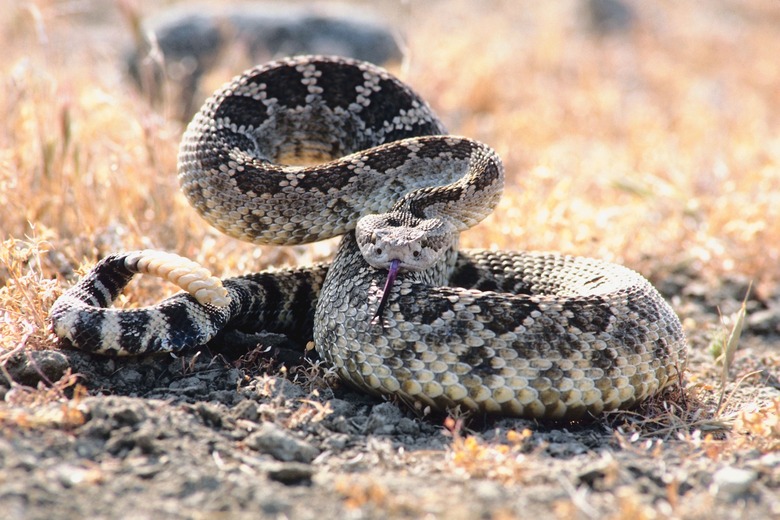Snakes & Spiders In Santa Fe, New Mexico
Santa Fe, N.M., is over 7,000 feet above sea level, which makes it difficult for cold-blooded animals such as snakes and to survive. Also, most spiders and snakes live in the prairie habitats surrounding Santa Fe rather than the city itself. Although not many snakes and spiders live in the Santa Fe area, some of the United States' most venomous species do dwell near the city. However, snake and spider bites are rare, and these animals will not bother humans if left alone.
Rattlesnakes
Rattlesnakes
The Santa Fe area is home to three rattlesnakes: western diamondback, prairie and ridgenose. The largest is the western diamondback, which grows to between 7 and 8 feet long as adults. The ridgenose rattlesnake is a threatened species in New Mexico. Rattlesnakes are also known as pit vipers, due to their facial pits. Heat sensors are in their facial pits; rattlesnakes use sensors to detect warm-blooded animals. Rattlesnakes also have rattles at the end of their tails. When threatened, rattlesnakes warn predators by shaking their rattle rapidly. These snakes are venomous, meaning they have high quantities of venom in their fangs.
Venomous Spiders
Venomous Spiders
Black widows and two recluse spiders, Arizona recluse and Apache recluse, are found in households in and around Santa Fe. These spiders prefer dark crevices with cool temperatures such as basements, garages and attics. Recluse spider bites result in necrosis, which is a disease that causes the premature death of skin tissue. Symptoms of recluse bites are the formation of black spots and skin lesions. Black widow venom has neurotoxins, and the black widow's bites cause dizziness, nausea, vomiting and fatigue. Only female black widows have high levels of toxicity. The Mayo Clinic recommends that people seek medical attention immediately if they are bitten by black widow or recluse spider.
Colubrids
Colubrids
Colubrids are a collection of nonvenomous snakes that catch prey by constriction, or wrapping their bodies around prey and suffocating them. While they are nonvenomous, colubrids will bite humans to defend themselves. One of the most common colubrids in northern New Mexico is the gopher snake. Also known as the bull snake, the gopher snake has a thick body and reaches lengths of 9 feet. A gopher snake will pose as a venomous snake when alarmed by flattening its head to a triangular shape and shaking its tail. Other colubrids in the Santa Fe area are common garter, plains black-headed, plains garter, western hog-nose and coachwhip snakes.
Non-Web Spiders
Non-Web Spiders
Trapdoor spiders are species that do not build webs to catch prey. These spiders live and nest in burrows and cover their burrows with trapdoors. The trapdoors are made of mud and silk. When prey pass by the trapdoor, this spider emerges and drags the prey into its burrow. Another spider species near Santa Fe is the tarantula, a large spider with hair on its legs and body. Tarantulas belong to the Theraphosidae family of spiders, which has the largest representation of non-web spiders in northern New Mexico at five species.
Cite This Article
MLA
Davis, Skip. "Snakes & Spiders In Santa Fe, New Mexico" sciencing.com, https://www.sciencing.com/snakes-santa-fe-new-mexico-8736001/. 24 April 2017.
APA
Davis, Skip. (2017, April 24). Snakes & Spiders In Santa Fe, New Mexico. sciencing.com. Retrieved from https://www.sciencing.com/snakes-santa-fe-new-mexico-8736001/
Chicago
Davis, Skip. Snakes & Spiders In Santa Fe, New Mexico last modified March 24, 2022. https://www.sciencing.com/snakes-santa-fe-new-mexico-8736001/
